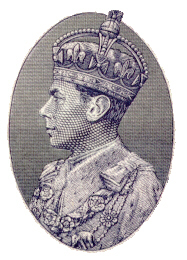 King George VI
Notes
King George VI
Notes
 King George VI
Notes
King George VI
Notes
George V breathed his last in 1936, and was succeded by his son EdwardVIII who soon had to abdicate. His younger brother George VI succeded him in 1937. The most importent event of this period (as far as currency notes are concerned) was the establishment of the Reserve Bank of India. The Reserve Bank of India was established in 1935 as a Central Bank, and the job of issuing notes was entrusted to this bank. Consequently, the office of Commissioner of the issue of currency came to be abolished and was substituted by the Governer of the Reserve Bank of India. Similarly, the issue offices scattered around the country came to be called as the regional offices of the Reserve Bank. As a result of these far reaching developments, the new notes bearing the effigy of George VI now had the authority of the Bank and the signature of it's Governor.
In the initial period, designs of George V were continued except for the change in issuing authority and the picture of George VI. The World War II, which began in 1939 had perilous consequences on the Indian Currency System. Hoarding of metallic coins led to the issue of 1 Rupee notes as described in the earlier chapter. A more serious threat came after the entry of Japan into the war. The Japanese tried to destabilise the Indian Economy with forged notes of 5, 10 and 100 Rupees. New designs with the frontal effigy of the monarch in watermark and in print were issued after 1942. The notes of 100 Rupees issued in a new design in 1938, were changed in respect of watermark. The new 1 Rupee notes were abolished in 1945.
The notes with portrait of George VI are known to bear signatures of J.B.Taylor and C.D. Deshmukh. On the 1 Rupee notes, the signature is of the Secretary of the Ministry of Finance, Mr. C.E.Jones.